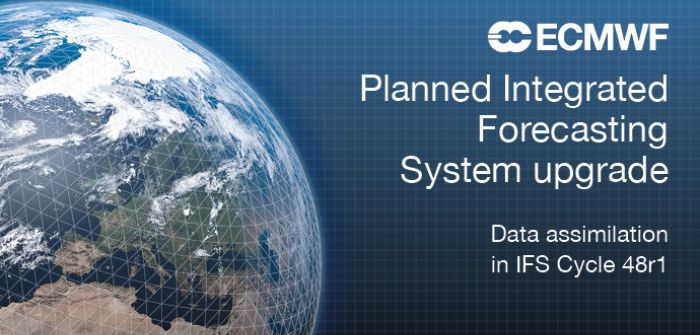Cycle 48r1 of ECMWF’s Integrated Forecasting System (IFS) – which is to become operational in summer 2023 – will include extensive changes to the way the initial conditions of weather forecasts are established.
The new cycle is expected to make better ’all-surface’ use of satellite microwave observations. The data obtained will be added to the many weather observations that help the organization to establish the initial conditions of weather forecasts through data assimilation. Other changes to the data assimilation system to be implemented in Cycle 48r1 include an increase in the resolution of the 4D-Var system used for the atmosphere and a move to a new software layer called object-oriented prediction system (OOPS).
The upgrade targets surface-sensitive microwave channels, for which a lot of data has previously been screened out due to surface types that are hard to simulate. These surface types include land, snow, sea ice and mixtures of all surface types. In some channels, the new developments increase the number of observations being assimilated by around 30%. For microwave imager channels, observations are used over most land surfaces for the first time.
Alan Geer, a scientist at ECMWF, said, “This is thanks to a new technique for extrapolating the surface radiative properties across frequencies, based on retrievals at lower frequencies that are less sensitive to cloud and precipitation. Observations from microwave imager channels are also added over ice-free polar oceans thanks to a new sea-ice retrieval. This enables us to accurately screen out any observations that contain sea ice, where previously we had to exclude all polar ocean areas as a precaution.”
According to the organization, it is still too difficult to use observations in this channel over sea-ice, snow, desert or high-altitude surfaces, so some big gaps to fill remain. In Cycle 48r1, more observations will be shown over land at high latitudes in a microwave humidity channel. The improved treatment of mixed surfaces has also allowed coastal scenes to be used for the first time.
Additional changes include treating snow and sea-ice as Lambertian surfaces (appearing uniformly bright from all directions of view) rather than specular surfaces (incident light is reflected into a single outgoing direction) in the radiative transfer for some microwave-sounding instruments. This, the ECMWF reports, leads to smaller biases and hence a better use of the data.
The wider use of satellite observations in Cycle 48r1 will bring measurable improvements to forecasts. The main improvements are in northern high-latitude areas, which ECMWF says shows the importance of trying to use more satellite data in these areas.
In addition to including more satellite observations, Cycle 48r1 brings some other improvements in data assimilation. One is an increase in the resolution of the 4D-Var data assimilation system by 20%, from about 50km to about 40km. This makes a big difference for particular phenomena, such as tropical cyclones. It is part of ongoing efforts to increase the resolution of the data assimilation system. OOPS is written in C++ instead of Fortran which makes it easier to maintain and develop the data assimilation environment.
“These changes make Cycle 48r1 a significant step in improving the data assimilation system at ECMWF,” said Tony McNally, the head of Earth system assimilation at ECMWF. “They also lead the way to exciting new developments over the next few years to further enhance our ability to exploit observations and improve forecasts.”



